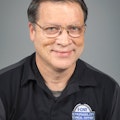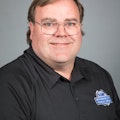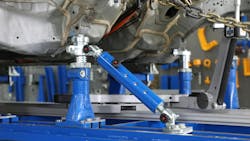Navigating structural collision repair complexity
Content brought to you by Auto Body Repair Network.
The collision repair process has evolved dramatically over the years. From traditional methods to advanced techniques, professionals in the industry have been presented with new challenges that are compounding year over year due to the increasing repair complexity.
Measuring, anchoring, and pulling: engineering precision restored
When it comes to repairing a vehicle's structural integrity, measuring, anchoring, and pulling play a crucial role. As modern vehicles utilize a range of materials, including multiple grades of steel, aluminum, magnesium, and composites, traditional methods may prove insufficient. We must know how far the collision energy has traveled into the vehicle and where the damage stops. No matter where that impact occurred on that vehicle, we must know what parts of the vehicle are still dimensionally correct and which ones are not.
That's really what we as technicians are trying to figure out as we move through that whole structural repair process. We need to make sure we're anchoring enough good points so that any pulling forces that we then exert on that vehicle structure aren't causing additional damage. One major challenge is the evolution to stronger and lighter materials. That makes it more difficult for a technician to repair structural damage. It doesn't always make it impossible, but what we're experiencing is that there's less repairability when there are visual indicators of damage.
How the role of anchoring and pulling have changed
It is becoming more frequent that we will need to measure, anchor and pull for part-replacement instead of repairing the part. A measuring, anchoring, and pulling process is still necessary to replace a part. Technicians used to do a lot of pulling to straighten back when we could add heat and the vehicles were made of milder steel. Today, we are not able to straighten many types of substrates because it’s prohibited in the OEM repair procedures. This is due to the metallurgy of these materials. What we are attempting to accomplish is to pull so that when we replace the damaged component, every part that the damaged component is attached to is dimensionally correct so that the joints align properly. For example, the strut tower and the aprons are pulled to the correct dimensions so that when we replace the frame rail, it fits, and everything lines up and we can properly weld it in. Without pulling to replace, there may be additional panel replacements required due to misalignment and poor fit that would otherwise not have been necessary.
However, there are always exceptions, and there are vehicles where pulling is prohibited because of the structural materials used, such as for aluminum-intensive vehicles. It’s always a crucial step to fully understand the OEM procedures and positions on straightening for the exact vehicle you are working on, as procedures may differ between model years and body styles.
Structural materials: Complex challenges, innovative solutions
The automotive industry's shift toward lightweight and higher-strength materials have brought forth a new level of complexity in collision repair. While these materials enhance fuel efficiency, vehicle performance, and crash energy management, they also present distinct difficulties. Repairing vehicles constructed with a mix of materials requires specialized knowledge and techniques.
Technicians must be well-versed in handling these materials to ensure the repaired vehicle retains its original structural integrity and safety features. Composite materials pose their own set of challenges, requiring specialized repair procedures, materials and equipment to restore the structural features of those vehicles.
When creating a plan for how the vehicle will be anchored, it is important to know how that vehicle is built around the anchoring points and any supplemental anchoring points.
It is equally important to understand what the substrate-pulling clamps will be attached to. It is critical to success to have a good understanding of the forces that will be applied during the pulling process and how the subsequent forces are distributed by the anchoring setup. These are all considerations that technicians must think about as they're anchoring and pulling that vehicle so that they don't end up causing unintentional damage.
Why the answer to “Should you do it?” is often “no”
Many of the challenges outlined can be tracked back to the simple concept of work-hardening. Once the structural component has bent and absorbed energy, we may not be able to undo the work-hardening. Even if it “looks pretty good,” for most of these advanced materials, even if the answer to “Can you do it?” is “yes,” the more important answer to “Should you do it?” is “no.” It is critical that we are careful and stringently adhere to those OEM procedures, because someone’s life may depend on it if that vehicle is put to the ultimate test of a subsequent collision.
Research the vehicle on the bench and learn the composition of each component related to the repair. Find out if the OEM says it is repairable, sectionable, or must be replaced if damaged. Understand heat restrictions and if the panels around it are deformed, discover if those panels are repairable as well. Structural adhesives in joints may also be a consideration, as it is nearly impossible to replace cracked or separated structural adhesives properly without separating the parts at the seam. There's a lot more research that must go in to determine repairability, and that level of research is multiplying.
The rise of OEM and vehicle-specific training: A paradigm shift
The rise of OEM and vehicle-specific training has emerged as a game-changer in the collision repair industry. As vehicles become more technologically advanced, manufacturers are increasingly implementing newer systems into their designs, such as advanced driver assistance systems (ADAS) and sensors. This shift necessitates a deep understanding of each vehicle's unique specifications and requirements.
Vehicle-specific training, whether from I-CAR, another third-party provider, or directly from an OEM, equips technicians with the knowledge and skills needed to handle the complexities of that manufacturer’s vehicles. I-CAR’s Vehicle and Technology Specific Training™ portfolio was designed to address the need for a curriculum that features the intricate technological systems and complex structural designs of modern vehicles. The Industry Training Alliance™ program also includes approved training from OEMs to reduce training redundancy for technicians.
The days of universally applying general repair procedures are long gone. Looking up the repair procedures for the exact vehicle, model and year on that day is critical for a complete, safe and quality repair. If a technician is stuck or doesn’t know where to start, there are resources available at no cost, like Ask I-CAR on I-CAR’s Repairability Technical Support Portal.
A changing landscape demands continuous learning
The landscape of collision repair has undergone a profound transformation, driven by technological advancements, evolving vehicle materials, and the demand for specialized training. Measuring systems offer precise insights, anchoring and pulling methods can restore dimensional alignment, and understanding complex materials is essential for effective repairs. The surge in OEM and vehicle-specific training underscores the industry's commitment to delivering safe and high-quality repairs in the face of increasing complexity through continuous learning. As collision repair professionals adapt to these changes, the pursuit of excellence remains paramount in ensuring the safety and satisfaction of vehicle owners. This work has not gotten easier. We have the utmost respect for the technicians who perform the repair correctly.
About the Author

Jeff Poole
Manager, Subject Matter Expert
Jeff first ventured into a commercial shop in the late ’80s and not long after that was enrolled in some I-CAR classes. Many days in the collision shop repairing vehicles and presenting I-CAR courses in the evenings eventually led to national I-CAR recognition, when Jeff was awarded “Instructor of the Year" for 2005.
From repairing vehicles as a technician to helping with the development of training materials for the collision repair industry here in the U.S. and viewed in other countries, with over 35 years in the industry Jeff is a sought-after subject matter expert when it comes to identifying the important aspects of a scenario and how it applies to collision (or other loss type) and vehicle repairs for application in educational resources.

Scott Kaboos
Principal, OEM Technical Relations Lead and Subject Matter Expert
Scott spent the first 20 years of his career in the collision industry as a structural repair technician. In that time, he worked for independent, dealership, and MSO shops. In 2014, he began a new chapter as a collision instructor at the High school and college level including becoming the Program Coordinator for the prestigious Fayetteville Technical College, Collision U program where he was recruited by American Honda to develop their collision technical training program. Scott is a 6 category I-CAR platinum individual, 3x Recertified ASE Master Collision technician and has earned AMCE and AMAM designations with AMI. He has also been a part-time welding instructor for I-CAR for the past seven years. In his spare time, Scott enjoys building street rods and restoring antique cars.
